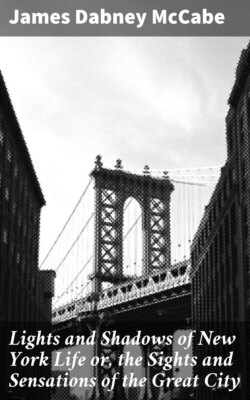Читать книгу Lights and Shadows of New York Life or, the Sights and Sensations of the Great City - James Dabney McCabe - Страница 20
На сайте Литреса книга снята с продажи.
IV. FASHIONABLE CHILDREN.
ОглавлениеTable of Contents
As it is the custom in fashionable society in New York to prevent the increase of families, it is natural no doubt to try to destroy childhood in those who are permitted to see the light.
The fashionable child of New York is made a miniature man or woman at the earliest possible period of its life. It does not need much labor, however, to develop “Young America” in the great metropolis. He is generally ready to go out into the world at a very tender age. Our system of society offers him every facility in his downward career. When but a child he has his own latch-key; he can come and go when he pleases; he attends parties, balls, dancing-school, the theatre and other evening amusements as regularly and independently as his elders, and is rarely called upon by “the Governor,” as he patronizingly terms his father, to give any account of himself. He has an abundance of pocket-money, and is encouraged in the lavish expenditure of it. He cultivates all the vices of his grown-up friends; and thinks church going a punishment and religion a bore. He engages in his dissipations with a recklessness that makes old sinners envious of his “nerve.” His friends are hardly such as he could introduce into his home. He is a famous “hunter of the tiger,” and laughs at his losses. He has a mistress, or perhaps several; sneers at marriage, and gives it as his opinion that there is not a virtuous woman in the land. When he is fairly of age he has lost his freshness, and is tired of life. His great object now is to render his existence supportable.
Girls are forced into womanhood by fashion even more rapidly than boys into manhood. They are dressed in the most expensive manner from their infancy, and without much regard to their health. Bare arms and necks, and short skirts are the rule, even in the bleakest weather, for children’s parties, or for dancing-school, and so the tender frames of the little ones are subjected to an exposure that often sows the seeds of consumption and other disease. The first thing the child learns is that it is its duty to be pretty—to look its best. It is taught to value dress and show as the great necessities of existence, and is trained in the most extravagant habits. As the girl advances towards maidenhood, she is forced forward, and made to look as much like a woman as possible. Her education is cared for after a fashion, but amounts to very little. She learns to play a little on some musical instrument, to sing a little, to paint a little—in short she acquires but a smattering of everything she undertakes. She is left in ignorance of the real duties of a woman’s life—the higher and nobler part of her existence. She marries young, and one of her own set, and her married life is in keeping with her girlhood. She is a creature in which nothing has been fully developed but the passions and the nerves. Her physical constitution amounts to nothing, and soon gives way. Her beauty goes with her health, and she is forced to resort to all manner of devices to preserve her attractions.
It is a habit in New York to allow children to give large entertainments at fashionable resorts, without the restraining presence of their elders. Here crowds of boys and girls of a susceptible age assemble under the intoxicating influence of music, gas-light, full dress, late suppers, wines and liquors. Sometimes this juvenile dissipation has been carried so far that it has been sharply rebuked by the public press.
